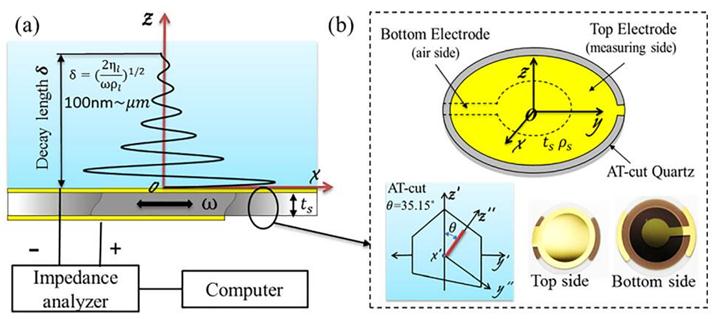Quartz Crystal Microbalance (QCM) Services
Inquiry
The quartz crystal microbalance (QCM) is an extremely sensitive detection tool that can measure changes in mass per unit area from nanogram to microgram levels. The QCM is suitable for vacuum, gas phase, and liquid media.
Basic principle
The QCM uses the piezoelectric effect of quartz crystals to convert the change in surface mass of quartz crystal electrodes into a change in frequency of the electrical signal output from the quartz crystal oscillation circuit. In turn, high-precision data is obtained through other auxiliary equipment such as a computer. The real-time test system can provide up to 200 data points per second, and researchers can use the data content to obtain useful information about the molecular interactions or reactions occurring at the electrode surface.
 Figure 1. Schematic illustration of (a) the work principle of QCM and (b) the quartz crystal chip. (Xiao X. Q., et al. 2016)
Figure 1. Schematic illustration of (a) the work principle of QCM and (b) the quartz crystal chip. (Xiao X. Q., et al. 2016)
Different types of QCM
| Category | Features |
| Conventional QCM | - Electrodes are commonly used with metals such as Au, Ag, Pt, and Ni.
- To improve the selectivity of the probe, membrane materials with specific selective recognition functions are often modified on the surface of the probe electrode. The membrane materials can be biological recognition elements, such as enzymes, antibodies, microorganisms, cells, plant and animal tissues, genes, etc., or chemical recognition elements.
- Static detection is generally used.
- Micro-mass measurements in gas and liquid environments can be performed, and frequency changes due to sample adsorption can be monitored in real-time.
|
| Dissipative QCM (QCM-D) | - Provides both frequency and dissipation factor data, thereby sensing subtle changes in mass and structure, etc., occurring on the crystal surface.
- It can detect the mass, thickness, density, viscosity, elastic modulus, dissipation factor, and conformational changes of the material surface, and is also capable of performing reaction kinetic simulations.
- Molecular interactions and molecular adsorption can be studied on many different types of surfaces. Applications include the interaction of proteins, DNA, lipids, polyelectrolytes, polymers, and cells/bacteria with surfaces or with adsorbed molecular layers.
- Detection is sensitive and rapid, with multiple frequencies and dissipation factor data available. The mass of very thin adsorbed layers can be determined and structural information such as viscoelasticity can be provided simultaneously.
|
| Array QCM | - Array QCM is equivalent to the integration of multiple QCMs, allowing simultaneous detection of multiple samples. The structures are multi-channel QCM, monolithic integrated array QCM, and time-scan excitation array QCM.
- It can process and detect multiple samples and obtain multiple sets of data at the same time.
- The real-time performance is better and can reflect the dynamic process, and more information can be obtained than traditional QCM, which meets the needs of the sensor array, miniaturization, and computerization of information processing.
|
| Electrochemical QCM (EQCM) | - EQCM not only takes advantage of the high sensitivity of electrochemical detection but also takes advantage of the fact that QCM can detect surface quality and damping in real time.
- EQCM can achieve the detection of QCM resonant frequency by detecting the frequency of the oscillator and then obtaining the QCM surface.
- The EQCM can detect the resonant frequency of the QCM by detecting the frequency of the oscillator, and then obtain the quality and viscosity of the QCM surface.
- Compared to normal QCM detection, EQCM can simultaneously detect QCM resonance parameters, current, and power variations with potential.
|
Range of applications
QCM can provide information such as the molecular thickness, structure, and water content of the adsorbed film. It can also detect changes in the surface adsorption layer before, during, and after the reaction. Dissipation factors can reflect the rigidity and flexibility of the quartz wafer surface sample and can be used to calculate surface viscosity and elastic modulus (interfacial rheology).
- Thin film thickness monitoring, electrochemistry, sensor studies.
- DNA and RNA interactions, molecular recognition, cell adhesion, liposomes and proteins, biofilm formation, and lipid membrane studies.
- Drug research, characterization of molecular layer mass and structural information, molecular adsorption, and interaction monitoring.
- Polymer coatings, surfactant research.
QCM has shown advantages as a highly sensitive trace detection tool for a variety of monitoring and bioanalysis. With low cost, high resolution, high sensitivity, good specificity, and real-time online monitoring. Creative Biostructure offers convenient QCM services to help our customers make progress in drug discovery, structural characterization, and more contact us to customize the latest solution for you.
Ordering Process

Reference
- Qiao X, et al. Progresses on the theory and application of quartz crystal microbalance. Applied Physics Reviews. 2016. 3(3): 031106.
 Figure 1. Schematic illustration of (a) the work principle of QCM and (b) the quartz crystal chip. (Xiao X. Q., et al. 2016)
Figure 1. Schematic illustration of (a) the work principle of QCM and (b) the quartz crystal chip. (Xiao X. Q., et al. 2016)